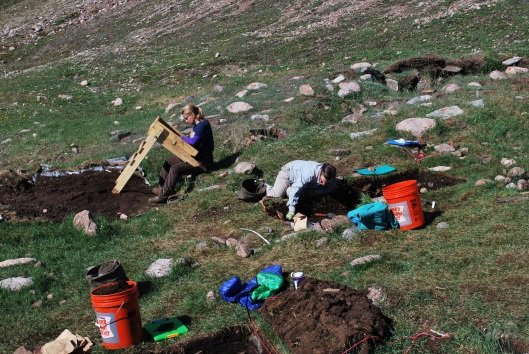Tags
If you were following us on Twitter or Facebook, then you have some idea of what we did all summer, but as wonderful as it was to be able to send out those daily updates, we often wished we could send along a photo or two as well. So now is our chance!
We have already talked about our travels to Greenland and the delays we encountered here and here. After that, actually getting to the site was a piece of cake – the weather was beautiful, the helicopter rides went without a hitch, and camp was set up in no time, in the footprint of our camp from 2006.

Our campsite, about a 30 minute walk from the site.
The site itself was much a we left it. I was pleased to see how well the site had recovered from our 2006 excavations. House 1 was fully recovered, and if anything more lush than before – something we noticed elsewhere as well.

House 1, before excavation in 2006

House 1 showing regrowth of vegetation after 10 years.
Based on the work we had done in 2006 and especially the testing John and Hans did in 2012, we had a good idea of where we wanted to put our excavation units, so it wasn’t long before we were at work.

Lara screening, and me digging in warm sunny weather.
We were lucky to have really good weather most of the time, but there were a few cold and wet days to remind us that we really were in the Arctic.

Jason bundled up for working in the cold and rain.
Excavations progressed rapidly, but in fact we found that we spent a good deal of our time screening. We had terrific stacked screens from Stoney Knoll, with 1/4” mesh on top, and 1/8” below to ensure that we collected both the tiny little auk bones that were so common, as well as even the tiniest stone flakes.

A typical view, with half the team screening while the others dig.
Of course the view was terrific as well,

view of the excavations from hill behind the site, taken by Nuka, who climbed up in record time
and we had an improvised sound system to help keep us focused on our work (and deter any roaming wildlife from getting too close).

Solar panels and a spare bucket turned out phones and a small speaker into a reliable outdoor sound system!
The end result was some very interesting excavations, including a number of buried early Thule features along with the Late Dorset levels we were most interested in. Here you can see part of a Thule feature in the lower right, with the Dorset levels visible as dark layers in the profiles.

One of our excavation blocks
We shipped home eight trunks full of material, which now awaits processing. In the next post I will talk in more detail about some of what we found.
